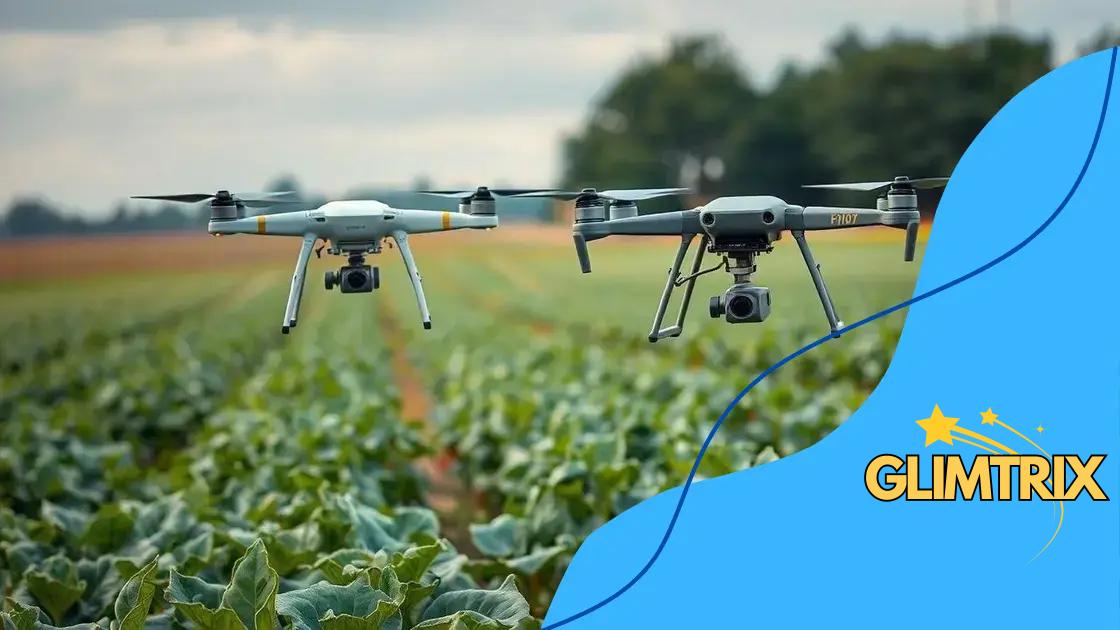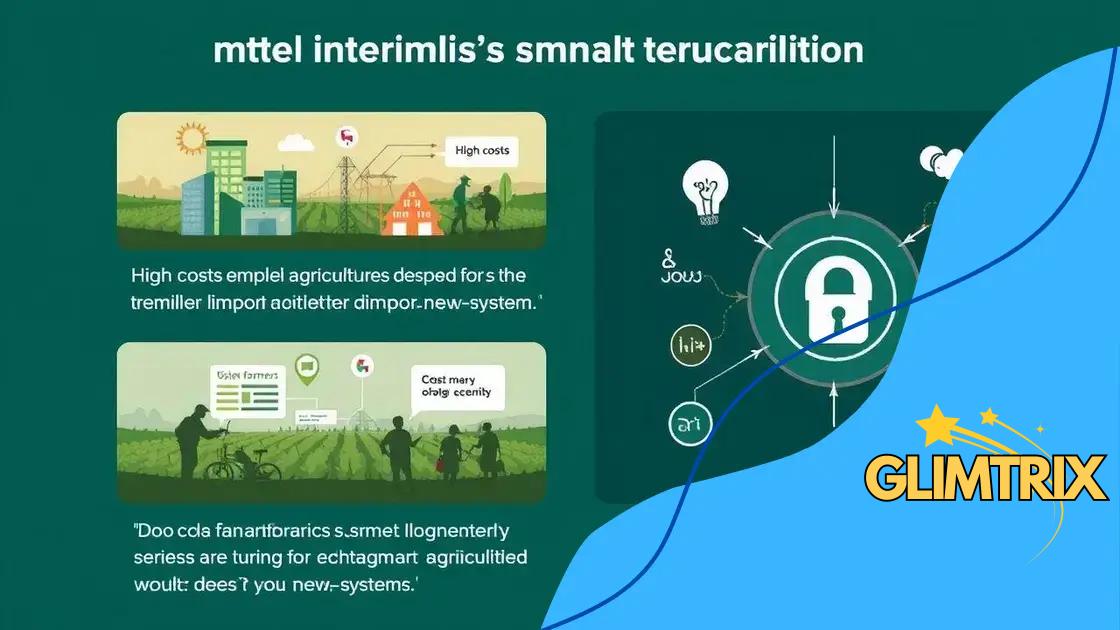Smart agriculture tech adoption trends you should know

Smart agriculture tech adoption trends focus on improving efficiency and sustainability through innovations like precision farming, automation, and data analytics, leading to enhanced yields and resource management.
Smart agriculture tech adoption trends are reshaping the farming landscape. With new technologies emerging, farmers can enhance productivity and make informed decisions. Curious about how these advancements could impact the agriculture sector? Let’s dive deeper into this exciting topic.
Current innovations in smart agriculture
Recent breakthroughs in smart agriculture are revolutionizing the way farmers work. From precision farming to automated systems, these innovations enhance productivity and sustainability. New technologies help farmers to monitor their crops closely and gather valuable data.
Precision Farming Techniques
Precision farming utilizes GPS and data analytics to optimize field-level management. By precisely applying inputs like water, fertilizers, and pesticides, farmers can reduce waste and increase yields.
- Benefits include lower input costs.
- Enhanced crop quality and yield.
- Reduced environmental impact through minimized chemical usage.
These techniques focus on efficiency and sustainability, making them attractive for modern agricultural practices.
Automated Systems and Robotics
Automation is also playing a key role in smart agriculture. Robotics is now used for tasks such as planting, harvesting, and even monitoring crop health.
- Robotic harvesters can operate faster than manual labor.
- Drones are used for aerial surveys, providing real-time data on crop conditions.
- Automated irrigation systems ensure crops receive the right amount of water.
These innovations save time and labor costs, allowing farmers to focus on decision-making and strategy. By integrating these technologies, growers can achieve higher productivity and better resource management.
Moreover, the use of data analytics helps in predicting weather patterns, which is essential for planning agricultural activities. Farmers can adjust their strategies based on forecasts, improving crop resilience.
Key benefits of adopting smart farming technologies
Adopting smart farming technologies offers numerous advantages that can significantly transform agricultural practices. These technologies enhance efficiency, promote sustainability, and lead to better crop management.
Increased Efficiency
Efficiency is one of the main benefits of smart farming. By leveraging tools like sensors and automated systems, farmers can optimize operations and save valuable time.
- Automated irrigation systems provide precise water delivery.
- Drones can monitor fields quickly and accurately.
- Real-time data helps farmers make timely decisions.
This increased efficiency means farmers can focus more on planning and less on manual tasks, ultimately improving their overall productivity.
Cost Savings
Implementing smart technologies can also lead to substantial cost savings. By using resources more effectively, farmers can reduce their expenditure on water, fertilizers, and pesticides.
- Precision agriculture minimizes waste through targeted application.
- Energy-efficient systems decrease operational costs.
- Access to data allows for better financial planning.
Cost savings enhance profitability, making smart farming an attractive option for many agricultural businesses.
The environmental impact also benefits from smart farming. By adopting smart agricultural practices, farmers can reduce their carbon footprint and promote sustainable land use. This is crucial for meeting the challenges posed by global climate change.
Furthermore, these technologies improve crop health and yield. With better monitoring and management, farmers can identify problems early and respond appropriately. This proactive approach ensures that crops receive the care they need to thrive, ultimately leading to higher production levels.
Challenges in implementing smart agriculture tech

Implementing smart agriculture tech presents various challenges that farmers and agricultural businesses need to navigate. Despite the benefits, there are obstacles that can hinder full adoption of these technologies.
High Initial Costs
One major challenge is the high initial costs of smart farming technologies. Farmers often need to invest in advanced equipment, software, and infrastructure.
- Purchasing drones and sensors can be expensive.
- Installation of IoT systems requires financial investment.
- Upgrading existing equipment may also be necessary.
These costs can be a barrier, especially for small to medium-sized farms, which may struggle with limited budgets.
Technical Knowledge and Training
Another significant challenge is the lack of technical knowledge among farmers. Adopting new technologies often requires learning and adaptation.
- Farmers may need training to operate complex systems.
- Continuous education is vital to keep up with evolving technologies.
- Support and resources from tech providers can be limited.
Without adequate training, the potential of smart agriculture technologies may not be fully realized, leading to frustration and inefficiencies.
Additionally, there is often concern over technology dependence. As farms become more reliant on tech solutions, any system failure could significantly impact productivity. Farmers need a well-thought-out plan to manage this risk effectively.
Data privacy and security are also critical issues. As smart farming technologies collect vast amounts of data, protecting this information becomes essential. Farmers must ensure that their data is secure from breaches and misuse.
Future outlook for smart agriculture practices
The future outlook for smart agriculture practices is bright, as technology continues to advance and reshape the agricultural landscape. With ongoing innovations, farmers are poised to achieve greater efficiency and sustainability in their operations.
Emerging Technologies
In the coming years, we can expect to see a rise in the adoption of emerging technologies such as artificial intelligence (AI) and machine learning. These tools will enhance decision-making processes by offering valuable insights based on data analytics.
- AI can optimize crop management with predictive analytics.
- Machine learning algorithms help improve the accuracy of forecasts.
- Automation will streamline labor-intensive tasks.
These advancements support farmers by enabling them to make more informed choices, ultimately increasing productivity.
Sustainability Efforts
The focus on sustainability is expected to grow as well, promoting environmentally friendly farming practices. Smart agriculture technologies are at the forefront of this initiative, allowing farmers to use resources judiciously.
- Utilizing precision farming reduces water and fertilizer waste.
- Integrating renewable energy sources can lower costs and carbon footprints.
- Crop rotation and covered cropping practices can enhance soil health.
These practices not only benefit the environment but also ensure food security for the growing global population.
Additionally, collaboration and data sharing among farmers and tech providers will likely increase. By working together, they can build more robust platforms and solutions to address challenges in agriculture.
The future of smart agriculture will also see improvements in accessibility, making these technologies available to a wider range of farmers. As costs decrease and education improves, more producers will be able to implement smart solutions effectively.
Case studies of smart agriculture success stories
There are numerous case studies that showcase the success of smart agriculture practices around the world. These examples highlight how farmers leverage technology to improve their operations and yield impressive results.
Drip Irrigation in California
One notable success story is in California, where farmers have adopted advanced drip irrigation systems. This technology delivers water directly to the roots of crops, ensuring efficient use of water resources.
- Farmers have reported a significant reduction in water usage by up to 30%.
- Crops show improved growth and yield due to consistent moisture levels.
- Costs associated with water procurement have also decreased.
This has made agriculture more sustainable and profitable in a state prone to drought.
Precision Farming in the Midwest
Another success story can be found in the Midwest, where a group of farmers has implemented precision farming techniques. Using GPS and data analytics, they can manage their fields with greater accuracy.
- Fertilizer application has been optimized, resulting in a 20% decrease in costs.
- Crop health monitoring has led to early detection of pests and diseases.
- Yields have increased by an average of 15% as a result.
This proactive approach not only enhances revenue but also supports environmental sustainability.
Additionally, in countries like Australia, farmers are utilizing drones for crop monitoring. Drones provide real-time data about crop health, allowing for quick interventions when issues arise. This technology has transformed how farmers assess their fields and make timely decisions.
These case studies demonstrate the transformative impact of smart agriculture technologies. They provide valuable insights and inspiration for other farmers looking to enhance their practices and embrace innovation.
FAQ – Frequently Asked Questions about Smart Agriculture Technologies
What are the main advantages of smart agriculture technologies?
Smart agriculture technologies increase efficiency, reduce costs, and enhance sustainability. They help farmers use resources more effectively and boost crop yields.
How can precision farming benefit my farming practices?
Precision farming uses data to optimize resource use, allowing for better crop management and reducing waste, which can lead to higher profitability.
What challenges might I face when implementing smart agriculture tech?
Challenges may include high initial costs, lack of technical knowledge, and concerns about data privacy and security, which require careful planning and support.
Can you give examples of successful smart agriculture practices?
Yes, successful examples include the use of drip irrigation in California, precision farming in the Midwest, and drone technology for crop monitoring.





